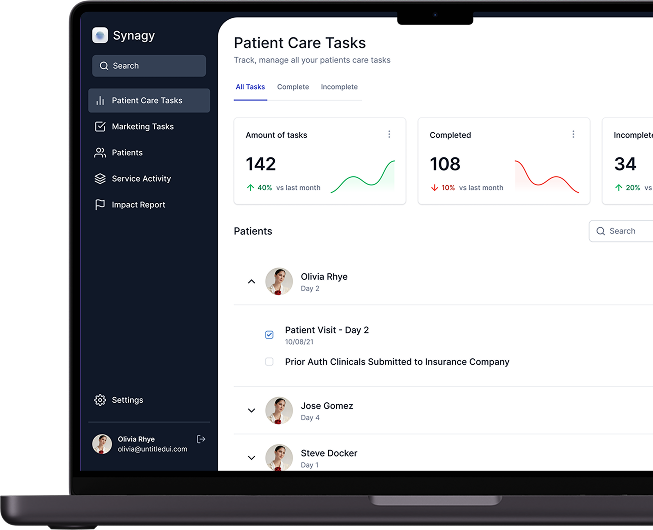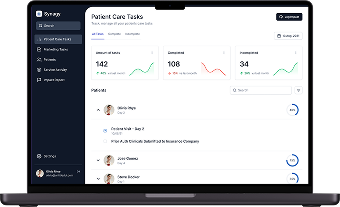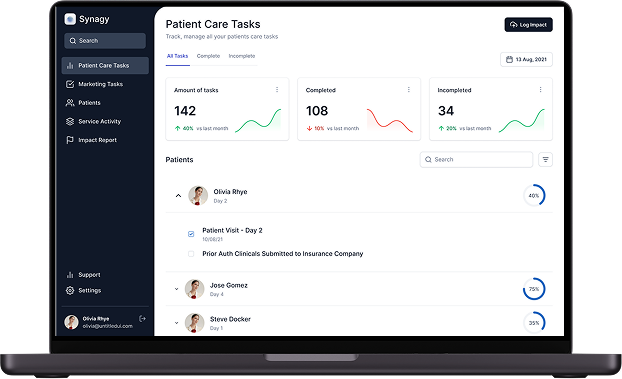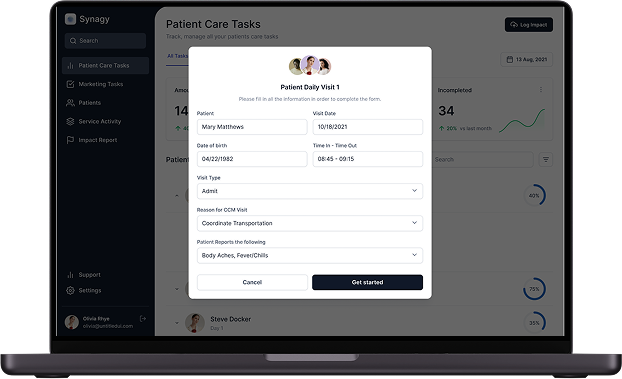HIPAA-Compliant Cloud-based Solution
Happen Technologies transformed a paper-based program serving substance-addicted individuals into a scalable digital solution used across multiple hospitals, enhancing efficiency, accessibility, and patient care.


Happen Technologies transformed a paper-based program serving substance-addicted individuals into a scalable digital solution used across multiple hospitals, enhancing efficiency, accessibility, and patient care.


A client providing support for substance-addicted individuals needed a custom software solution to modernize their operations. Their existing program relied entirely on paper-based processes, creating inefficiencies in patient tracking, data management, and coordination across multiple hospital locations. To address these challenges, Happen Technologies was brought in to design and develop a scalable, digital platform tailored to the client’s unique needs.
The custom-built solution provided secure, centralized patient data management, allowing hospitals to track progress, manage treatment plans, and coordinate care more effectively.
The program was integrated within existing healthcare establishments, not standalone clinics.
The system was manual, requiring a shift to a digital platform for patient management, insurance reimbursement, and marketing operations.
The solution needed to scale to hundreds of hospitals while ensuring data security and HIPAA compliance.
Led a 6 week discovery, learning the client’s business operations and then mapping 100’s of forms and reports to future technology flows.
Automate flows in patient care, insurance, and marketing.
Created a scalable cloud-based solution for nationwide implementation.
Centralized patient data management w/ proper separation between individual hospitals.
Ensured regulatory compliance with secure data handling.
In the Discovery Phase, our team at Happen Technologies worked closely with the client to understand the existing manual workflows surrounding patient management, community development, and insurance reimbursement. Through stakeholder interviews and a thorough analysis of the program’s service offerings, we identified critical pain points that were limiting scalability and operational efficiency. Using this information, we crafted a detailed requirements specification which served as the foundation for designing the scalable digital solution.
The Discovery Phase resulted in a detailed requirements document and clickable prototype that captured stakeholder needs and laid the foundation for a scalable digital solution. This phase streamlined the transition from manual processes to a more efficient, digital workflow, setting the stage for the next steps in design and development.
The Discovery Phase resulted in a detailed requirements document and clickable prototype that captured stakeholder needs and laid the foundation for a scalable digital solution. This phase streamlined the transition from manual processes to a more efficient, digital workflow, setting the stage for the next steps in design and development.
We designed a HIPAA-compliant, cloud-based software platform designed to enhance operational efficiency, patient care, and security. The platform includes key components:Patient Care
Built for scalability, the platform is designed to easily scale across hundreds of hospitals, ensuring long-term adaptability and data security, meeting all regulatory requirements.


Over the course of nine months, our team developed the Minimum Viable Product (MVP) for the client’s software solution, ensuring it was HIPAA-compliant and capable of supporting the client’s existing customers and their future growth. We leveraged a robust technology stack to build the reliable, scalable platform:
The development phase was focused on delivering a fully functional MVP that met the core needs of the client, ensuring regulatory compliance, data security, and optimal performance when scaled across hundreds of healthcare systems. The platform was designed for flexibility, allowing for future enhancements as the program expands.
The software proved to be a transformational asset for the client, streamlining operations, improving efficiency, and enhancing patient care management. Its successful implementation allowed the client to transition from a paper-based process to a fully digital platform, ultimately enabling them to sell their company to a major healthcare conglomerate.
With the project’s initial success, we are now slated to begin Phase Two of development this year, collaborating directly with the buying organization to scale the platform further and integrate additional features to meet the needs of an even broader user base. This marks the beginning of a new chapter for the software, as it continues to drive innovation and support the growth of healthcare systems nationwide.
Digitalized
Digitalized
Digitalized
Organizations often choose AWS over Azure for HIPAA-compliant systems due to its broader range of HIPAA-eligible services and their mature healthcare track record. AWS also offers strong security tooling and a rich partner ecosystem for healthcare integrations. It’s often preferred by teams needing flexibility, scalability, and proven compliance support across regions.
Manual patient tracking caused data silos, delays, and errors across multiple hospital sites. By digitizing and centralizing the process, care coordination improved significantly, along with billing accuracy and treatment visibility.
We’re not into “reinventing wheels”. Whenever possible, we start with what we often refer to as “boiler-plate code”. In this case, we utilized a .NET-based application development framework that offers modular layered architecture, secure CRUD user/role management, error logging, and more. This allowed us to get started quickly and save our client significant money without sacrificing quality or security.